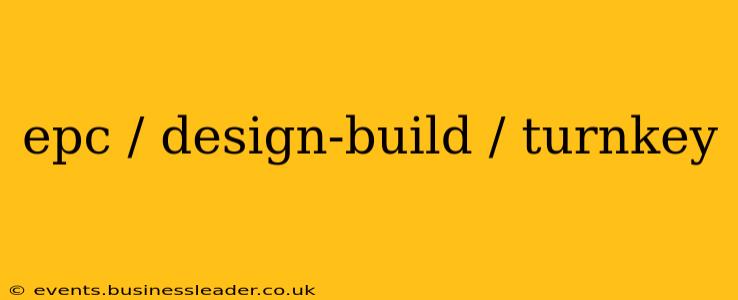The engineering, procurement, and construction (EPC) model, design-build approach, and turnkey projects are all popular methods used in various industries for completing large-scale projects. While they share similarities, understanding their nuances is crucial for choosing the right project delivery method. This guide will clarify the differences between EPC, design-build, and turnkey projects, highlighting their respective advantages and disadvantages.
What is EPC (Engineering, Procurement, and Construction)?
EPC is a project delivery method where a single contractor—the EPC contractor—takes responsibility for the entire project lifecycle. This encompasses engineering design, procurement of materials and equipment, and construction management. The client provides the overall project scope and specifications, and the EPC contractor manages all aspects of the project's execution.
Advantages of EPC:
- Single point of accountability: The client deals with a single entity, simplifying communication and liability.
- Faster project completion: Streamlined processes often lead to shorter project timelines.
- Cost certainty (potentially): A fixed-price contract can offer better cost control, although this depends on the contract's specifics and the project's complexity.
- Expertise consolidation: The EPC contractor typically brings together a team of specialized engineers and contractors.
Disadvantages of EPC:
- Higher upfront costs: The client typically pays a higher upfront fee for the contractor's comprehensive services.
- Limited client control: Once the contract is signed, client input might be limited.
- Risk transfer: The EPC contractor bears significant risk, which may be reflected in the contract price.
What is Design-Build?
Design-build merges the design and construction phases under a single contract. A single entity (or a joint venture) is responsible for both the design and construction aspects of the project. This differs from the traditional design-bid-build approach, where design and construction are handled by separate entities.
Advantages of Design-Build:
- Improved collaboration: Closer integration between design and construction teams leads to better coordination and efficiency.
- Faster project completion: Streamlined processes often result in quicker project delivery.
- Cost savings (potentially): Early involvement of construction professionals can lead to cost-effective design choices.
- Increased innovation: Design-build allows for more creative solutions and value engineering.
Disadvantages of Design-Build:
- Potential for design compromises: The need to balance design with construction constraints can sometimes lead to design compromises.
- Risk allocation: Careful consideration of risk allocation between the client and the design-build firm is crucial.
- Finding the right firm: Selecting a qualified and reputable design-build firm is critical for project success.
What is Turnkey?
A turnkey project is delivered ready to operate. The contractor takes on full responsibility, from initial concept and design to final commissioning and handover. The client essentially "turns the key" and the project is ready for immediate use. Turnkey projects often incorporate elements of both EPC and design-build.
Advantages of Turnkey:
- Simplicity for the client: The client's involvement is minimal, making it an attractive option for those lacking in-house expertise.
- Guaranteed functionality: The contractor ensures the project operates as specified.
- Reduced client involvement: The client only needs to define the project's scope and objectives.
Disadvantages of Turnkey:
- Higher cost: Turnkey projects are generally the most expensive option due to the comprehensive nature of the services.
- Limited client control: Clients relinquish significant control over the project's execution.
- Potential for hidden costs: The all-encompassing nature can mask unforeseen expenses.
What are the Key Differences Between EPC, Design-Build, and Turnkey?
The main difference lies in the level of responsibility and the extent of services provided by the contractor. EPC focuses on the engineering, procurement, and construction aspects. Design-build integrates design and construction. Turnkey takes it a step further, delivering a fully operational project. Essentially, Turnkey often includes EPC and design-build elements, but isn't strictly defined by them.
Which Method is Right for My Project?
The best project delivery method depends on various factors, including project complexity, budget, timeline, client expertise, and risk tolerance. Careful consideration of these factors is vital before making a decision. Consulting with experienced project managers and industry professionals can provide valuable insights and guide the selection process.
How do I choose between EPC and Design-Build?
The choice between EPC and Design-Build hinges on your comfort level with risk and control. EPC offers a higher degree of certainty (though not always) but less control. Design-Build allows for more collaboration and potential cost savings but requires closer involvement throughout the project.
What are the risks involved in a turnkey project?
The primary risks in turnkey projects involve cost overruns, schedule delays, and potential disputes over project specifications. Careful contract negotiation and due diligence are crucial to mitigate these risks.
This detailed explanation provides a comprehensive understanding of EPC, design-build, and turnkey projects, helping businesses make informed decisions based on their unique project requirements and goals. Remember to seek professional advice tailored to your specific situation.
